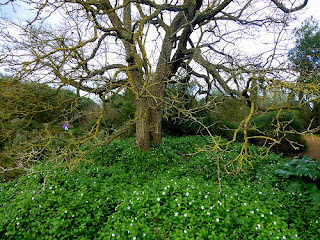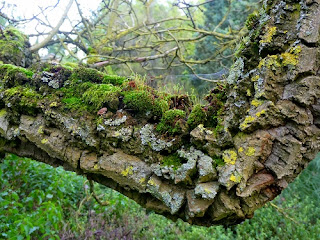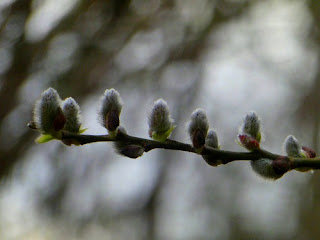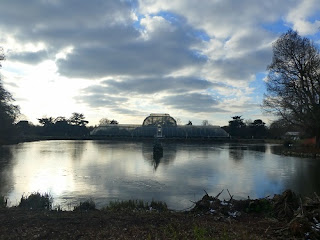
It quickly became a weekly fixture, a ritual almost: I'd cycle to Chiswick, collect my friend Cally and then we'd pedal along the river to Kew Gardens. She'd pack two flasks of soup and some bread, I'd buy the cakes and eventually the coffees, we'd walk, find a bench - no matter how cold - for lunch, walk some more. pick up the coffees and sit opposite the palm house for afternoon tea, walk some more and cycle back before dark. It became, apart from Zoom classes, a highlight of the week, a much-anticipated day out at the end of each busy week (after the first cycle, we fixed on Fridays). One Friday we missed because I was feeling peaky and hoped it wasn't Covid-19 (it wasn't); on another, we had less time to spare so we resolved to meet at Barnes Pond and explore the Leg o' Mutton nature reserve (a former reservoir), sandwiched - unbeknownst to us until then - between the river and the road to Barnes. As the London Wetlands Centre has been closed for the whole of this year up to now, this was the next best thing.

The beauty, of course, was to see the steady return to life of plants and trees. to catch the Thames and the Gardens in so many changing lights and temperatures. We persist even now, but in order not to swamp you with photos, I've stuck to the first two months. The first jaunt took place on 6 January. This was the scene near the eyot at Chiswick
and this the tree-canopied stretch from Chiswick Bridge to the Gardens
What was flowering or budding then? Near Kew Palace, Syringa x hyacinthiflora, 'Lamartine';
a camellia near the Japanese Temple
and various Hamelidacaeae, the family to which the Witch Hazel belongs - this is Parrolia persica, the Persian ironwood, another finer speciment of which we'll come across in a later week.
Otherwise, only bracket fungus here and there.
Every week we'd keep a watch on the buds of the magnolia grove - the big oak behind always looks splendid, whatever the season -
and cross the main pond, larches now skeletally dominant
then head up to the view across the river to Syon House, where we had several lunches.
The woods were awaiting their snowdrops, and still in places looked autumnal
Fading light (mid-afternoon) around the Pagoda and its dragons,
the Temperate House
and the Palm House.
Closing time was officially 3pm, though I think we were out later, and catching sunset on the river back at the eyot at 4pm.
15 January expedition: first catkins
and some fine lichen on firs.
Coldish lunch by the Thames
and then into the woods to see the first snowdrops.
Ubiquitous ring-necked parakeet at the feeders with various tits.
First signs of tentative blossoms on the fruit trees near the Temperate House, now in full spate.
Then the usual routine - heading to the cafe to carry away coffees to the other side of the pond (the former archive building catches the sun, which has tended to shine on our visits)
and a pleasant wend towards Alpine territory, via the ever-fascinating Hive,
to catch what we could: a few exquisite narcissi
and heavenly-scented paperwhites just inside the open door of the Alpine House,
curiously drosera-like growths on the rockery
and spectacular sedums which a few weeks later would need to be under wraps in sub-zero temperatures
plus a detour beyond the wall to see if anything was growing in the vegetable beds - answer, Swiss chard -
and to catch a glimpse of promises beyond: Sparrmania africana of the mallow family
and knobbly beginnings of Crambe cordifolia.
Grasses still flourishing which had been cut back on our most recent visit
and a tentative Chinomanthus praecox 'Lutea', another version of which we'd find giving off fabulous scent a few weeks later.
So to the gate at sunset
and a very rewarding cycle back - the river front at Kew Green glowing;
what is now the Budweiser brewery seen once we'd crossed the bridge;
while at the eyot a surprise awaited, not an entirely unfamiliar one as the Thames does tend to come up over the road and pavement at high tide, and I'm always happy to wait and watch until it recedes a bit - but this was spectacular. Stranded cars parked on the slipway are an all too regular occurrence here.
Canada geese relishing the grass of one of the Chiswick Mall gardens a bit further along
and last sunset perspectives before the homeward stretch.
22 January: a brilliant start by the stone or umbrella pine, Pinus pinea, which Joseph Hooker moved to this spot in 1846 from Princess Augusta's original collection.
The mountain gum further along, Eucalyptus dalrympeana, is already of massive girth though only planted in 1971.
New to me were the trees in the rockery and glade around King William's Temple. Here, the Chilean Colletta spinosissima
has gathered some fine lichen.
Beyond, in the grove dominated by date plum trees, Ehretia dicksonii is nicely mossy.
Another Persian ironwood, this time in the wooded zone, is rich in red berries
Clouds were rolling in as we passed the Temperate House
and there was a curious desolation about the dead gunnera leaves by one of the smaller ponds in the woods.
Swan seeking self-shelter
but nearby, signs of new life in the first iris of the year, Iris lazica from the Caucasus,
and in the tentative yellow flowering of the Cornelian cherry.
More new life on the other side of the lake
and as we headed back to the gate, the clouds began to lift and the late afternoon sun started to strike through.
Final grand illumination of the big trees near Kew Palace, Orangery and Nash Conservatory
Further light on Kew Green
and a bright moon by the time we reached the eyot (you can just see it high and left of centre in the first picture below).
29 January marked a departure from the routine. We both had limited time, so as I'd heard of Egyptian goslings newly hatched on Barnes Pond, I thought we could meet there and go on to explore the Leg o' Mutton reserve (I heard about both of these from my peregrine-watching new friends in Margravine Cemetery). Hadn't bargained for a very high tide and, having decided to ride through the high water, got soaked and decided to shelter by the Putney boathouses until it subsided. Again, a car was sinking fast (transport police eventually towed it away).
The walkway by the Thames had become a channel for swans and geese to glide along
After 30 lively minutes of waiting, the waters retreated enough for me to resume the journey. I feared I'd be way too late, but as I cycled towards Barnes Pond, I saw Cally pedalling towatds me. She'd had exactly the same problem on the other side of the river, but had been able to go home and change. Anyway, we didn't see the goslings, only their parents on the island in the middle, but the pond was pleasant enough
and I hadn't realised there was an arts centre (serving much-needed coffees to take away). Another five or so minutes, and we were at the Leg o' Mutton. The river side of the old reservoir on the circular walk is the most attractive, as you have water on both sides (and of course the Thames was still high).
Bird life was unexceptional but abundant and picturesque, especially with reeds as background,
and the late afternoon light lent an eerie charm to the place.
5 February: back to Kew. The first crocuses were coming through
as well as the shoots of the first peonies (cambesedsii in the Alpine Garden).
The witch hazel below the Temple of Aeolus had further blossomed
and Chimonanthus praecox 'grandiflora' was heady in its scent - at this point we could have been deluded into the thought that spring had arrived.
A ubiquitous robin only to commemorate our lunch on a bench on the rise towards the William Temple - this was our constant companion.
Amazing natural (sap?) striations on a Spanish chestnut tree in the woods
and an abundance, now, of snowdrops.
Again, abrupt change of weather - dark clouds as we reached the river.
Firsr rhododendron in flower, campanulatum 'notturno'
and an oblique take on one of the Chinese red-barked birches (Betula albosinensis) in a grove I always seek out.
Dramatic light by the Hive
and redwings, which I'd been following almost daily in the Margravine Cemetery, here in abundance too.
Back to the gate
and moody river scenes on the cycle home.
Though we'd missed the first brief bout of snow at Kew, we returned on the 12th in the big freeze, and still patches of the latest fall.
The light was bright, and magnolia buds well advanced against the background of the mighty oak suggest it was more clement than it felt,
but you can see the partial freeze on the main lake.
Nothing daunted, we had our lunch on a bench near the river, faces turned to the sun and well wrapped up against the wind which blasted us from behind (the chill factor must have made it at least -3).
Didn't quite feel how the cold had got into our bones as we wandered the woods again
and appreciated the liveliness of various tits at the collection of feeders
but I'll never forget the intense sensation of cold at this seemingly benign point as we headed towards the Temperate House (closed, of course, and we were so looking forward to gleaning what warmth we could buying coffees and running hot water over our hands in the for once welcoming toilets).
The pond by the Palm House was also, of course, semi-frozen
but once again the Aeolus hillock and its foreground witch hazel look surprisingly benign.
Seek snow, though, and ye shall find little patches
even on the Alpine rockery agave.
Only cycling back warmed us up. Highish tide again
and presumably the parents of the swan family at the eyot.
Looking back once more to Chiswick.
Real progress at last on 26 February (can't remember why we missed a week). The long-awaited magnolia flowers in that wonderful glade were beginning to open, and the crocus carpet beneath was a bonus.
Further beds of crocuses down by the river
which offered a welcome journey back, and an even more magical moon (full, this time) at the eyot.
In the next and final batch, which will complete the year of London nature in lockdown, you'll finally see a riot of blossom. And I'm looking forward to returning to the Wetlands tomorrow, open this week for the first time this year.


















































































































































